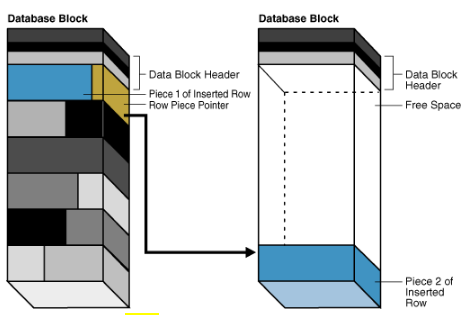Whenever DML operation performed in oracle database ,there are two situations where a data row may not fit into a single data block:
Row chaining The row is too large to fit into one data block when it is first inserted, or the table contains more than 255 columns (the maximum for a row piece).In this case, Oracle stores the data for the row in a chain of data blocks (one or more) reserved for that segment.Row chaining most often occurs with large rows, such as rows that contain a column of datatype LONG or LONG RAW.Row chaining in these cases is unavoidable.Due to insertion of a large row in a data block. The row is too large for the left block, so the database chains the row by placing the first row piece in the left block and the second row piece in the right block.

Row Migration A row that originally fit into one data block has one or more columns updated so that the overall row length increases, and the block's free space is already completely filled.
In this case, Oracle migrates the data for the entire row to a new data block, assuming the entire row can fit in a new block.
Oracle preserves the original row piece of a migrated row to point to the new block containing the migrated row.The rowid of a migrated row does not change.The left block contains a row that is updated so that the row is now too large for the block. The database moves the entire row to the right block and leaves a pointer to the migrated row in the left block.
 When a row is chained or migrated, I/O performance associated with this row decreases because Oracle must scan more than one data block to retrieve the information for the row.
When a row is chained or migrated, I/O performance associated with this row decreases because Oracle must scan more than one data block to retrieve the information for the row.
Row chaining The row is too large to fit into one data block when it is first inserted, or the table contains more than 255 columns (the maximum for a row piece).In this case, Oracle stores the data for the row in a chain of data blocks (one or more) reserved for that segment.Row chaining most often occurs with large rows, such as rows that contain a column of datatype LONG or LONG RAW.Row chaining in these cases is unavoidable.Due to insertion of a large row in a data block. The row is too large for the left block, so the database chains the row by placing the first row piece in the left block and the second row piece in the right block.

Row Migration A row that originally fit into one data block has one or more columns updated so that the overall row length increases, and the block's free space is already completely filled.
In this case, Oracle migrates the data for the entire row to a new data block, assuming the entire row can fit in a new block.
Oracle preserves the original row piece of a migrated row to point to the new block containing the migrated row.The rowid of a migrated row does not change.The left block contains a row that is updated so that the row is now too large for the block. The database moves the entire row to the right block and leaves a pointer to the migrated row in the left block.

- Row chaining is typically caused by INSERT operation.
- Row migration is typically caused by UPDATE operation
No comments:
Post a Comment